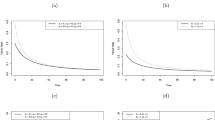Abstract
A system is considered, which is subject to external and possibly fatal shocks, with dependence between the fatality of a shock and the system age. Apart from these shocks, the system suffers from competing soft and sudden failures, where soft failures refer to the reaching of a given threshold for the degradation level, and sudden failures to accidental failures, characterized by a failure rate. A non-fatal shock increases both degradation level and failure rate of a random amount, with possible dependence between the two increments. The system reliability is calculated by four different methods. Conditions under which the system lifetime is New Better than Used are proposed. The influence of various parameters of the shocks environment on the system lifetime is studied.
Similar content being viewed by others
References
A-Hameed MS, Proschan F (1973) Nonstationary shock models. Stoch Process Appl 1 (4):383–404
A-Hameed MS, Proschan F (1975) Shock models with underlying birth process. J Appl Probab 12 (1):18–28
Brown M, Proschan F (1983) Imperfect repair. J Appl Probab 20 (4):851–859
Cha JH, Finkelstein M (2009) On a terminating shock process with independent wear increments. J Appl Probab 46 (2):353–362
Cha JH, Mi J (2007) Study of a stochastic failure model in a random environment. J Appl Probab 44 (1):151–163
Cha JH, Mi J (2011) On a stochastic survival model for a system under randomly variable environment. Methodol Comput Appl Probab 13 (3):549–561
Erhan Çinlar (2011) Probability and stochastics, volume 261 of Graduate texts in Mathematics. Springer Science + Business Media
Cocozza-Thivent C (1998) Processus stochastiques et fiabilité des systèmes, volume 28 of Mathématiques et Applications. Springer
Esary JD, Marshall AW, Proschan F (1973) Shock models and wear processes. Ann Probab 1 (4):627–649
Finkelstein M, Cha JH (2013) Stochastic modeling for reliability: Shocks, burn-in and heterogeneous populations. Springer Series in Reliability Engineering. Springer, London
Gut A (2001) Mixed shock models. Bernoulli 7 (3):541–555
Gut A, Hüsler J (1999) Extreme shock models. Extremes 2 (3):295–307
Hao H -B, Su C, Qu Z -Z (2013) Reliability analysis for mechanical components subject to degradation process and random shock with wiener process. In 19th International Conference on Industrial Engineering and Engineering Management
Lehmann A (2006) Degradation-threshold-shock models. Probability, Statistics and Modelling in Public Health
Lehmann A (2009) Joint modeling of degradation and failure time data. J Stat Plan Inf 139 (5):1693–1706. Special Issue on Degradation, Damage, Fatigue and Accelerated Life Models in Reliability Testing
Lemoine AJ, Wenocur ML (1985) On failure modeling. Nav Res Logis Q 32 (3):497–508
Mallor F, Omey E (2001) Shocks, runs and random sums. J Appl Probab 38 (2):438–448
Mallor F, Santos J (2003) Classification of shock models in system reliability. Monografías del Semin. Matem. García de Galdeano 27:405–412
Mallor F, Santos J (2003) Reliability of systems subject to shocks with a stochastic dependence for the damages. Test 12 (2):427–444
Marshall AW, Shaked M (1979) Multivariate shock models for distributions with increasing hazard rate average. Ann Probab 7 (2):343–358
Nakagawa T (2007) Shock and damage models in reliability theory. Springer Series in Reliability Engineering. Springer, London
Qian C, Nakamura S, Nakagawa T (1999) Cumulative damage model with two kinds of shocks and its application to the backup policy. J Oper Res Soc Jpn -Keiei Kagaku 42 (4):501–511
Savits TH (1988) Some multivariate distributions derived from a non-fatal shock model. J Appl Probab 25 (2):383–390
Shaked M, Shanthikumar JG (2006) Stochastic orders. Springer Series in Statistics. Springer
Singpurwalla ND (1995) Survival in dynamic environments. Stat Sci 10 (1):86–103
Skoulakis G (2000) A general shock model for a reliability system. J Appl Probab 37 (4):925–935
Wang HW, Gao J (2014) A reliability evaluation study based on competing failures for aircraft engines. Eksploatacja i Niezawodnosc: Maint Reliab 16 (2):171–178
Zhu Y, Elsayed EA, Liao H, Chan LY (2010) Availability optimization of systems subject to competing risk. Eur J Oper Res 202 (3):781–788
Author information
Authors and Affiliations
Corresponding author
Rights and permissions
About this article
Cite this article
Mercier, S., Pham, H.H. A Random Shock Model with Mixed Effect, Including Competing Soft and Sudden Failures, and Dependence. Methodol Comput Appl Probab 18, 377–400 (2016). https://doi.org/10.1007/s11009-014-9423-6
Received:
Revised:
Accepted:
Published:
Issue Date:
DOI: https://doi.org/10.1007/s11009-014-9423-6
Keywords
- Reliability
- Bivariate non homogeneous compound Poisson process
- Hazard rate process
- Poisson random measure
- Stochastic order
- Ageing properties
- Two-component series system




